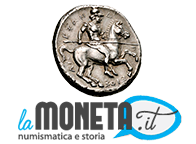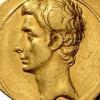Cerca nel Forum
Risultati per Tag 'NAC'.
Trovato 2 risultati
-
Ciao, anche se spesso il mio campo d'interesse è attirato dal tribolato III secolo, continuo a subire il fascino dell'oricalco. Di seguito posto delle monete a mio avviso stupende, proposte da NAC (http://www.arsclassicacoins.com/), asta 74, 18 novembre 2013. Questa so che attirerà l'attenzione di Mirko 8710 AUGUSTUS, January 16 , 27 BC– August 19, 14. M. Salvius Otho. Triumphal bronze as or dupondius, Rome 7 BC, Æ 19.54 g. Obv. CAESAR AVGVST PONT MAX TRI-BVNIC POT Laureate head of Augustus left; in right field, Victory left adjusting Augustus’ laurel-wreath with right hand and holding cornucopia in left hand; border of dots. Rev. . M × SALVIVS × OTHO × III × VIR × A × A × A × F × F × around S - C; border of dots. Literature Cohen 518–519 BMC RE I, 43, 224, pl. 20, 5 RIC I2, 75, 429; BN 686 R. Göbl, Antike Numismatik, Munich, 1978, 2819 (this coin) H. A. Grueber, “Roman Bronze Coinage from B.C. 45–3”, NC 1904, 56, pl. XIV, 9 G. E. Rizzo, La base di Augusto, Rome, 1933, p. 101 (obverse, this coin) Kent-Hirmer pl. 39, 140 (obverse) Wealth of the Ancient World 122 (this coin) M.-M. Bendenoun, Coins of the Ancient World, A Portrait of the JDL Collection, Tradart, Genève, 2009, 46 (this coin). Condition Very rare and undoubtedly the finest specimen known. A wonderful portrait struck on a very large flan and an untouched dark green patina. Extremely fine. Provenance Sotheby’s, Hunt sale I, New York 1990, lot 122. Bank Leu AG 10, Zürich 1974, lot 25. Naville & Co-Ars Classica 11, Luzern 1925, lot 224. Naville & Co 2, Genève 1922, Lot 176. From the Weintraub, Levis, and Vautier - Collignon collections. Note When Tiberius entered Rome in 7 B.C. to assume his second consulship, he also celebrated the triumph he had been awarded for his successful campaigns of recent years, notably in Germany. The distinctive bronzes that show Augustus crowned by Victory are linked to this event by Mattingly, Dressel, Giard, Carson, Kent and Sutherland. The moneyers M. Salvius Otho, P. Lurius Agrippa and M. Maecilius Tullus are thought to comprise the college of 7 B.C., as only they produced these bronzes. There is no consensus on denomination, as their weights range from less than 10 to more than 17 grams, and they are struck on planchets that sometimes are too small for the dies and other times are markedly oversized and with somewhat ornamented borders. It is possible that more than one denomination was intended, as Sutherland proposed by describing some as dupondii and others as asses. Mattingly tentatively describes them as dupondii, but refers to them as a ‘Triumphal Coinage,’ and Grant and Giard classify them as medallions rather than coins. After the event that merited this triumphal coinage had passed, Tiberius’ honours continued in 6 B.C. with his being awarded the tribunician power for another five years. With Marcus Agrippa and Nero Claudius Drusus recently deceased, and Augustus’ grandsons still young, everything pointed to Tiberius being Augustus’ successor, even if he had never been the first choice. However, Tiberius soon found life in the capital intolerable: he disliked his civilian duties, detested his wife Julia, and he must have realised that his high honours were little more than interim measures by Augustus, who was awaiting the maturation of his grandsons Gaius Caesar and Lucius Caesar. Thus, in 6 B.C. he left Rome for eight years of self-exile on the island of Rhodes, returning only after Gaius and Lucius were dead, and Augustus had no other viable option for a successor. TIBERIUS, 17 (?) September 14–March 16, 37. In the name of Agrippina died October 18, 33. Struck by Gaius, March 18, 37–January 24, 41. Sestertius, Rome 37–41, Æ 30.58 g. Obv. AGRIPPINA M F MAT C CAESARIS AVGVSTI Draped bust of Agrippina right; border of dots. Rev. S P Q R / MEMORIAE / AGRIPPINAE Carpentum drawn by two mules left; the cover supported by figures, and with ornamented side; border of dots. Literature Cohen 1 BMC RE I 159, 85, pl. 30, 6 RIC I2, 112, 55 BN 128 Kent-Hirmer pl. 47, 164 (obverse) and 46, 164 (reverse) Sutherland 292–293 W. Trillmich, Familienpropaganda der kaiser Caligula und Claudius Agrippina maior und Antonia augusta Berlin 1978, Gruppe III Wealth of the Ancient World 124 (this coin) M.-M. Bendenoun, Coins of the Ancient World, A Portrait of the JDL Collection, Tradart, Genève, 2009, 49 (this coin). Condition Very rare and among the finest specimens known. A delicate portrait of sublime style, Tiber tone. Extremely fine. Provenance Tradart Genève SA, Genève 1993, lot 197. Sotheby’s, Hunt sale I, New York 1990, lot 124. Bank Leu AG 7, Zürich 1973, lot 338. From the Hunt and Weintraub collections. Note Agrippina Senior was among the most deserving, yet least fortunate of the Julio-Claudian women. After her marriage in A.D. 5 to Augustus’ preferred heir, Germanicus, she was poised to achieve a status on par with the empress Livia. However, with the death of Augustus and the accession of Tiberius, power within the dynasty shifted decisively from the Julians to the Claudians. Even though Agrippina’s marriage offered a union of the two bloodlines, her prospects did not survive under Tiberius. When Germanicus died at Antioch late in A.D. 19 under suspicious circumstances, Agrippina devoted herself to opposing Tiberius and his prefect Sejanus. Finally, in 29, Tiberius deprived her of freedom, and in 33 she died in exile. Three issues of sestertii were struck for Agrippina Senior, all posthumously. The first, produced by her son Caligula, shows on its reverse a carpentum; the second, issued by her brother Claudius, has on its reverse a large SC surrounded by a Claudian inscription; the third is a restoration of the Claudian type by the emperor Titus (79-81), whose inscriptions are substituted for those of Claudius. The obvese inscription on Caligula’s issue, AGRIPPINA M F MAT C CAESARIS AVGVSTI, describes Agrippina as the daughter of Marcus (Agrippa) and the mother of Gaius (Caligula). Claudius’ inscription also identifies her as Agrippa’s daughter, but ends GERMANICI CAESARIS, thus shifting the focus from her being the mother of Caligula to being the widow of Claudius’ deceased brother Germanicus. Distinctions in the portraits follow the same lines as the inscriptions: on the issue of Caligula, Agrippina has a slender profile like that of her son, whereas on Claudius’ her face is broader and fuller, in keeping with his appearance.
-
Buonasera! Oggi sto navigando fra le varie aste nuove e passate e non ho potuto fare a meno di notare un Clodio Macer nella prossima asta Rauch. Questo: Peso: 3,73g Questo esemplare, o meglio, questa tipologia (legenda al dritto continua), è conosciuta dal 2007 (almeno in aste pubbliche), in un'asta NAC, quando fece 50000 Franchi: Peso: 3,46g Lo stesso esemplare è ripassato in asta nel 2012, sempre NAC e sempre 45000 Franchi, dichiarato come proveniente dal Tunis Hoard. Appare chiaro come i due esemplari abbiano lo stesso conio, sia al Dritto che al Rovescio. La cosa che però mi sorprende di più è anche la impressionate somiglianza delle fratture dei due tondelli, guardate: Sovrapponendoli, la cosa, è ancora più evidente. Vogliate sforzare un attimino gli occhi :D La mia domanda, quindi, è quella del titolo...sono lo stesso salamino? Dubito che il buon vecchio Macer si sia messo a fare gli stampini per i tondelli, troppo tempo, era più facile e veloce il cilindro d'argento? Le sorprese non sono finite qua...nel 2009 compare un altro esemplare, stessa tipologia, stessi conii, stavolta solo 26000 Franchi; il tondello è evidentemente ricostruito. Peso: 2,89g Ebbene, tre Denari, con solo una coppia di conii e tutti e tre con delle somiglianze nel tondello abbastanza "importanti". La terza moneta, come potete vedere sotto, ha delle fratture più grosse, ci stiamo allontanando dai primi tagli e i solchi si stanno allargando... Tecnici del Forum, illuminatemi! :D
- 22 commenti
-
- 1
-

-
- Clodio Macer
- conio
-
(e altri 3 tag)
Taggato come:
Lamoneta.it
La più grande comunità online di numismatica e monete. Studiosi, collezionisti e semplici appassionati si scambiano informazioni e consigli sul fantastico mondo della numismatica.
Il network
Hai bisogno di aiuto?




